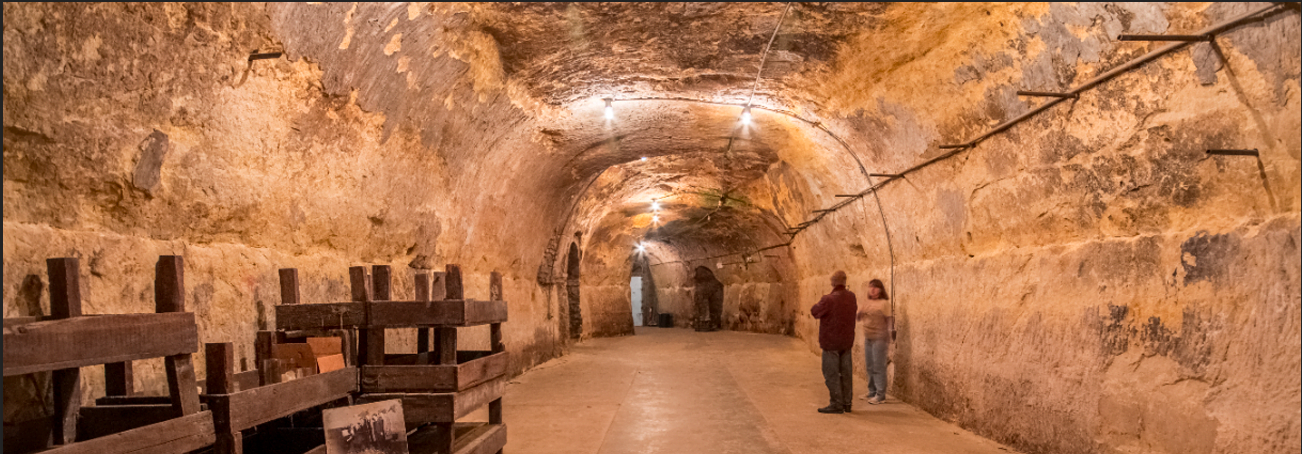When the twin cities were still in their infancy and growing into the metropolises they would become, a family of mushroom farmers took on the gargantuan task of carving out the sandstone nearby the Mississippi river in St. Paul into caves and tunnels. Finishing their masterpiece in the 1840s, they used the space to grow their mushrooms and eventually create a mushroom empire, shipping their fungi wares all over the country. The farmers couldn’t know that their safe caves would one day become a hot spot for gangsters and well-to-do St. Paulians to gamble, party, and eventually, murder. They couldn’t have predicted that the caves would live on in infamy as another kind of hot spot, either. The kind where spirits and phantoms walk the tunnels and caverns.

Today, we’re exploring the Wabasha Street Caves in St. Paul, Minnesota and the haunting tales that are told about its history and present.
After the mushroom farmers moved on, a brewery would continue their work, building an additional mile worth of caves to store beer and liquor safely in the cool sandstone caves. It’s worth mentioning that while they are called “caves,” the underground complex is man-made, so they are actually mines, not caves. During prohibition, the caves transformed into a popular speakeasy, as the liquor laws in Minnesota were not enforced as harshly as in other parts of the country. From 1933-1940, a night club known as the Castle Royal set up shop in the caves, catering to those who wanted a hard drink and a place to gamble or dance the night away. It featured more carved out rooms for privacy and a grand bandstand, which attracted another class of customers, namely gangsters.
One of the most famous visitors to the caves is that of the infamous gangster John Dillinger, who was rumored to have danced at the night club shortly before his death at the hands of the FBI in Chicago in 1934. He and his gang were said to be regulars while in the area, and Dillinger himself was known as a charming and polite guest, dancing the night away with pretty girls every time he visited. Another famous name who may have spent nights reveling at the club was Ma Barker, said by J. Edgar Hoover to be one of the most dangerous and resourceful criminals of his career. She would also meet her demise in Florida in 1935, again by FBI agents.

The Wabasha Caves hide another ruthless part of gangster activity within its carved rooms and passageways. One evening, four men who were part of an organized crime family sat around a table playing cards in one of the rooms of the caves, enjoying the warmth from a large fireplace and the big band music being played on the bandstand. Another well-dressed gentleman, carrying some kind of silver case, walked into the room and asked the band to finish up their set early. As the band left and the speakeasy closed for the night, a waitress volunteered to stay behind and clean up when the men were finished with their card game.
The brave waitress was in the kitchen when the sound of gunshots echoed through the caves. Terrified, she called the police and continued to hide in the kitchen. When they arrived, they chastised her for filing a false report, as there were no signs of any bodies in the room. She pointed out the bullet holes in the sandstone walls and thus her story was corroborated. The legend goes that three of the men playing cards were shot with a tommy gun and the man with the case and his accomplice from the card game buried the bodies in a room deeper into the caves, never to be seen again.

Stories like this only fuel the reputation of the Wabasha Street Caves as haunted by ghosts of the past, and gangsters who never left the cave, both literally and in a supernatural way. Reports from those who have experienced the paranormal within the caves say the spirits do not feel malicious and instead are friendly and not afraid to appear in front of patrons. Dozens of full-bodied apparitions have been sighted, walking through the sandstone walls. A gentleman in a pajama cap has been seen wandering, before turning a corner and disappearing. Occasionally, when the time is right, a man and woman will meet at the bar at 3:00 am, shortly after closing. It’s been suggested these spirits may be recreating a clandestine meeting. A theater troupe once reported the ghostly appearance of a man in the audience while they were practicing for a new play, who would appear often as if watching the show.
More stories spin a positive light on the spirits of long-dead gangsters in the caves: they say that the spirits have a soft spot for children. Former owners tell the story of their son encountering the spirit of a gangster in the men’s bathroom, chasing after a lost ball, who was straightening his tie in the mirror. The spirit turned to the young boy, smiled and winked, and then blinked out of existence. Another little one attending a wedding in the caves told his parents that he liked playing with the three men in the other room. When wedding photos came back, there were ghostly figures surrounding the boy in more than one image. Tour guides have shown this photo to patrons, theorizing it could be the three murdered gangsters, taking some time in their ghostly purgatory to be kind to a small child.

Today, the Wabasha Street Caves offer tours, including historic, gangster and ghost tours, and is also a popular venue one can rent out for celebrations, weddings, and more. The current proprietors embrace the past, ghosts and all, of the unique space and welcome others to experience it for themselves. From a mushroom farm, to a speakeasy, a night club, and eventually a wedding venue, these caves have seen the history of the St. Paul from under the very ground it’s built upon. If you feel brave or curious enough, don’t forget to join them for one of their swing dancing nights, or tour the tunnels where gangsters left bullet holes in the sandstone to remember them by.
- About the Author
- Latest Posts

Born in Death Valley and raised on the prairie, Deborah is a Wyoming-based paranormal researcher and University of Wyoming graduate. Her interests lie in folklore, history, symbolic interaction and research. She also researches the paranormal academically and is a graduate student studying sociology.


